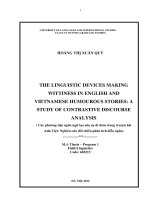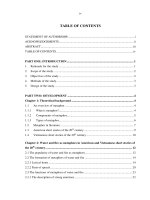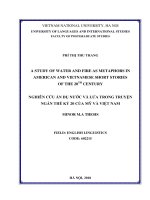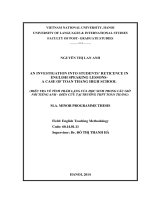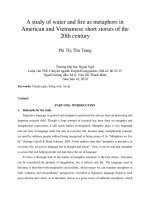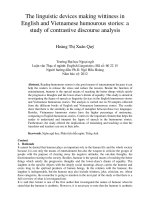An investigation into discourse markers in conversations used in english and vietnamese short stories (tt)
Bạn đang xem bản rút gọn của tài liệu. Xem và tải ngay bản đầy đủ của tài liệu tại đây (221.5 KB, 26 trang )
THE UNIVERSITY OF DANANG
UNIVERSITY OF FOREIGN LANGUAGE STUDIES
VÕ THỊ NHUNG
AN INVESTIGATION INTO DISCOURSE
MARKERS IN CONVERSATIONS USED IN
ENGLISH AND VIETNAMESE SHORT STORIES
Major : ENGLISH LINGUISTICS
Code : 822.02.01
MASTER THESIS IN
FOREIGN LANGUAGES, LITERATURE AND CULTURE
(A SUMMARY)
Da Nang, 2018
This thesis has been completed at
University of Foreign Language Studies, The University of Da Nang
Supervisor: Dr. Hồ Sĩ Thắng Kiệt
Examiner 1: Assoc.Prof.Dr. Trần Văn Phước
Examiner 2: Assoc.Prof.Dr. Nguyễn Văn Long
The thesis will be orally defended at the Examining Committee
Time: 26th October, 2018
Venue: University of Foreign Language Studies – The University
of Da Nang
This thesis is available for the purpose of reference at:
- Library of University of Foreign Language Studies, The
University of Da Nang.
- The Information Resources Center, The University of Da Nang.
1
CHAPTER 1
INTRODUCTION
1.1. RATIONALE
Literature is the foundation of life. It expresses an emphasis on
many issues from human life and society in all time. It is claimed that
literature has the role to reflect real things both in mental and
physical life. Literature is an integral part of language and it is a
useful means to show the beauty of a language. Literature helps
people to see through the lenses of others and sometimes even
inanimate objects. Literature, therefore, provides people with a lot of
experiences from sad stories and happy ones which can touch in
heart. With writers, to reach beauty in a word, they use varieties of
linguistic means. One of the useful literature means is discourse
markers.
In fact, discourse markers are referred to as linking words,
linking phrases and sentence connectors, they are the “glues” which
help the content of the text to become smooth and attractive to
readers. Warner (1988) stated that “Discourse markers are discourse
lubricants which help us to introduce a topic of conversation, to link
what we have to say to what someone has just said to agree or
disagree, to respond to what we have heard” [48, p.4]. This is the first
important reason why I choose to study the discourse markers (DMs).
Furthermore, I will focus on investigating the use of discourse
markers because the knowledge of discourse markers helps people to
apply in teaching foreign languages in general and language skills in
particular.
2
Let’s compare the following two examples – one without
DMs.
1.
Freddy: I don’t want to interrupt you.
Lind Seth: How can I help you?
Freddy: I like to ask you to sign a permission slip to take the
course you teaching next term.
Lind Seth: I’m glad you decide to take it…
[5, p.74]
In (1) there are not any mistakes with conversation structure,
with the informative exchange, but this conversation is not authentic
and it lacks the communicative interaction signals.
2.
Freddy: Excuse me, I don’t want to interrupt you…
Lind Seth: No, no. it’s quite alright. How can I help
you?
Freddy: Well, I would like to ask you to sign a
permission slip to take the course you are teaching
next term.
Lind Seth: Of course, Freddy. Actually, I’m glad
you have decided to take it…
[5. p.74]
A conversation can only be real if it contains DMs that help to
catch listeners’ attention such as “excuse me”, or replying “no” or “of
course”, or limiting the meaning with “would like/actually/quite”,
and even fillers to smoothen the conversation like “well”.
From the two examples, it can be seen that DMs, play active
roles in discourse. In most cases, some factors decide the successful
3
interaction: the introducers, the social context, the state of
consciousness, and the communication control. Obviously, House
and Edmondson (1981) stated that “a conversational gap that might
hinder the smooth flow of an ongoing talk” [44, p.69], so DMs play
the role of the discourse lubricant that help to plug.
With these above mentioned reasons, I decide to conduct a
study
entitled
“AN
INVESTIGATION
INTO
DISCOURSE
MARKERS USED IN SHORT STORIES IN ENGLISH AND
VIETNAMESE”.
1.2. AIMS AND OBJECTIVES
1.2.1 Aims
The study aims to examine the discourse markers used in short
stories in English and Vietnamese in order to provide learners with
knowledge of discourse markers in these short stories so that they
will able to use them more accurately in their English learning.
1.2.2. Objectives
This study is intended to:
- Investigate the discourse markers used in short stories in
English and Vietnamese.
- Apply the discourse marker theory in order to analyze
semantic and syntactic features used in the short stories in English
and Vietnamese.
- Make suggestions for language teaching and learning.
4
1.3. SCOPE OF THE STUDY
This research aims at investigating discourse markers used in
short stories in English and Vietnamese. This research concentrates
on investigating the collection of stories of women writers in the
mid-21st century and this research only concentrates on investigating
the short stories which have from 1,000 words to 1,200 words.
1.4. RESERCH QUESTIONS
The study tries to answer the following questions:
1. What are the discourse markers used in the short stories in
English?
2. What are the discourse markers used in the short stories in
Vietnamese?
3. What are the similarities and differences of the discourse
markers used in the short stories in English and Vietnamese?
1.5. SIGNIFICANCE OF THE STUDY
The intention of this study is intended to express the functions
and features of discourse markers the communicative interaction
signals - doing functions to lubricate a conversation and to help
Vietnamese learners of English as well as language teachers know all
about the three functions of discourse markers in short stories in
English and Vietnamese. Besides, it helps the learners to understand
more about the importance of using discourse markers as a means of
lubricating sentences. Moreover, the study provides learners with
knowledge of discourse markers used in the short stories in English
and Vietnamese in order to apply in teaching and learning English.
5
1.6. ORGANIZATION OF THE RESEARCH
This study has 5 chapters as follows:
Chapter 1: “Introduction”
Chapter 2: “Literature Review”
Chapter 3: “Methods and Procedures”
Chapter 4: “Findings and Discussion”
Chapter 5: “Conclusion”
6
CHAPTER 2
LITERATURE REVIEW AND THEORETICAL
BACKGROUND
2.1. LITERATURE REVIEW
Discourse markers expressions like well, but… are one set of
linguistic items that function in discourses of various styles or
registers. Fraser (1998) calls discourse markers “a growth market in
linguistics” (p.8). Since the late 1980’s discourse markers have been
studied in a variety of languages and examined in a variety of genres
and interactive contexts, though many scholars do not agree on how
to define them, even what to call them. Redeker (1991) calls them
discourse operators and defines them as “a word or phrase, for
instance, a conjunction, adverbial, comment clause, interjection that
is uttered with the primary function of bringing to listener’s attention
a particular kind of the upcoming utterance with the immediate
discourse context” (p.168) Schiffrin (1987) defines discourse markers
at a more theoretical level as “members of a functional class of verbal
and nonverbal devices which provide contextual coordinates for
ongoing talk” (p.41). Fraser (1998) defines “a discourse marker is a
lexical expression which signals the relation of either contrast (John
is fat but Marry is thin), implication (John is here, so we can start the
party), or elaboration (John went home. Furthermore, he took his
toys)” (p.302). Discourse markers have variant degrees of semantic
meaning, they are utterance-initial and they can signal a discourse
relationship or signal a writer’s or a speaker’s attitude.
A text that is well organized requires cohesion and
coherence at the same time. Building sentences, in a way, is the
7
organization of a written discourse and a text. But unlike putting up
one brick on another, sentences must relate to each other and
discourse needs to follow grammatical rules. Halliday and Hasan
(1976) identify five main cohesive devices in English discourse:
reference, substitution, ellipsis, lexical cohesion and conjunction.
Halliday defines conjunction, or connective element, as discourse
markers, which are the use of formal sentences to connect separate
sentences, clauses and paragraphs to one another. The use of
conjunction is different to that of reference, substitution and ellipsis
in a way that it provides no instruction to the readers in supplying
missing information by finding it somewhere else in the sentence and
by filling structural slots. By contrast, conjunction support the writers
by connecting what is about to be mentioned to what has been
mentioned previously.
There are a lot of research on discourse markers which are
related to this research:
Schiffrin (1983) analyzed how individual expressions can be
used to constitute conversational interaction and making discourse
cohesive. Such language tools were supposed to be discourse markers
with semantic function, apart from attitudinal devices that present the
speaker’s attitude on the proposition (Biber, 1999).
Biber, (1999) conceived such linguistic devices as discourse
markers with semantic function; besides attitudinal devices
expressing the speaker’s attitude toward the proposition typically
conveying an evaluation, value judgment, or assessment of
expectation were examined thoroughly.
8
Jones (1990) points out some techniques of DMs. The author
states that hesitation is a natural part of using a language. Most
people need to hesitate a lot during a conversation. Expressions
useful for this aim are how shall I put it?, let’s see now, you see, you
know, actually…
Recently, there have been some Vietnamese researchers such
as Diep Quang Ban (1999) Nguyen Thien Giap (2002) who suggest
using backchannels such as tốt thôi, để xem đã, thế à, ừ, à… as one
of the ways to facilitate the continuation of a conversation. These
expressions indicate to the speaker that his or her message has been
received.
Diep Quang Ban (1999) presents cohesive devices and divides
link words into four categories according to their semantic relations
like Halliday’s: Additive, Adversative, Casual, Temporal…
Until now, a number of previous studies have shown the
importance of syntactics or, semantics, but there have been few the
authors mentioning two features: syntactics and semantics as this
paper. Some master studies at the University of Da Nang will be
used at references as:
Nguyen Van Muoi (2011) “A Study of the Syntactic,
Semantic, and Pragmatic Features of Discourse Markers Only and in
Vietnamese Translational Equivalents” deals with the syntactic,
semantic, and pragmatic generalizations on linking words. Bui Thuy
Linh (2011) “An Insightful Investigation into Discourse Markers in
the Conversation of the Current English Textbooks Used in
Vietnamese High Schools from a Pragmatic Perspective” deals with
9
discourse markers in the conversation that are useful for preventing a
conversation from a sudden closure.
Ha Nguyen Bao Tien (2003), in her master thesis “An
Investigation into Stance Markers Affecting the Content of the
Utterance” investigates the structure relation between the constituent
presenting the personal stance and the constituent presenting the
qualified proposition.
Besides, there has been so far no research into discourse
markers used in short stories in English and Vietnamese, so I have
decided on the thesis entitled “AN INVESTIGATION INTO
DISCOURSE MARKERS USED IN SHORT STORIES IN
ENGLISH AND VIETNAMESE”.
2.2. THEORETICAL BACKGROUND
2.1.1. Semantic features
2.1.2. Syntactic features
2.2.1. The concept of discourse
2.2.2. Features of discourse
2.3.1. Discourse markers
2.3. SUMMARY
10
CHAPTER 3
RESEARCH METHODOLOGY
3.1. RESEARCH METHOD
In this study, I use two research methods in investigating the
data: qualitative and quantitative methods. The qualitative method is
used in analyzing data so that I can find out the discourse markers
used in short stories in English and Vietnamese. Besides, the
quantitative method is used to identify the rate and provide statistics
of frequencies of occurrence in percentage which helps to have clear
evidences. In addition, some other methods can be employed in the
study:
Firstly, the descriptive method provides a detail description of
discourse markers used in short stories in English and Vietnamese.
Secondly, the analytic method is used in order to clarify and
justify certain aspects in detail. In addition, it is very necessary to
have a deep appreciation about the data in short stories in English and
Vietnamese. Finally, the synthetic method is used in order to give a
whole insight of the discourse markers.
3.2. DATA COLLECTION
3.3. DATA ANALYSIS
3.4. RESEARCH PROCEDURES
The procedure of the study is carried out by the following
steps:
- Downloading the data of the short stories in English and
Vietnamese
11
- Reading theoretical background of discourse markers.
- Reading samples in the data of the short stories in English
and Vietnamese
- Reading some previous researches related to this study.
- Classifying of samples in terms of the mentioned linguistic
features and analyzing them.
- Finding out discourse markers used in the short stories
3.5. RELIABILITY AND VALIDITY
3.6. SUMMARY
12
CHAPTER 4
FINDINGS AND DISCUSSION
4.1. OCCURENCES AND FREQUENCY OF DISCOURSE
MARKERS
IN SHORT
STORIES IN
ENGLISH
AND
VIETNAMSES
Table 4.1: Occurrences and Frequency of DMs in Short Stories
Types
Openers
Links
Responders
Closers
of DMs
Polite
Total
markers
Occurrences
128
758
121
3
2
1012
Frequency
12.64%
74.9 %
11.95%
0.29%
0.19%
100%
4.1.1. Links
DMs and conjunction that are considered to be in this
type are respectively ones that contribute to develop
conversation and state the connection among propositions.
Table 4.2: Occurrences and Frequency of Links in Short
Stories
Meanings
DMs
Occurrence
Adversative
But
296
Frequency
39.
Total
296
05%
Additive
Causal
..too,
5
..either/neither
1
And
409
so
37
54.75%
415
4.88%
37
13
Temporal
then
10
10 1.32%
10
4.1.2. Openers
This includes all DMs and tokens employed to initiate a
conversation, to start off a question/ suggestion/ topic.
Table 4.3. Occurrences and Frequency of Openers in Short Stories
Meanings
DMs
Getting attention
Oh,
Occurrence
well, 108
Frequency
Total
84.38%
108
ok, yes, now
Introducing
First, next
7
5.7%
7
Opinion
think/guess
1
0.78%
1
Action strategies
Would you 10
aspects of a topic
12
like…?
Can/could
2
9.37%
…
4.1.3. Responders
DMs of this type appear in replies
Table 4.4. Occurrences and Frequency of Responders in
Short Stories
Meanings
Agreement/disagree
ment
DMs
Yes
Occurren
Frequen
Tot
ce
cy
al
78
82.03%
105
14
too
15
No
5
Sure
6
Of course
1
Acknowledgement
Know/see
1
0.78%
1
Compliment
Great
2
7.81%
10
9.4%
12
It’s
very 3
nice
5
thanks
Modality
Perhaps/ma
7
ybe
5
Little, too
4.1.4. Closers
The occurrence of closing DMs prepares interlocutors a
farewell. Usually they are in last turns.
Table 4.5: Occurrences and Frequency of Closers in Short
Stories
Meanings
DMs
Occurrences
Total
Total
Frequency
Casual
Thanks/good
closing
bye
Formal
Not at all
2
3 66,7%
3
1
133.33%
1
15
Closing
4.1.5. Polite Markers
Including in the group are honorifics: please, kindly..
Table 4.6. Occurrences and Frequency of Polite Markers in
Short Stories
Meaning
Softening
DMs
the please
Occurrences
Total
2
2
face threat
4.2. SYNTACTIC FEATURES OF DMS IN ENGLISH AND
VIETNAMESE
4.2.1. Positions of DMs in Sentence
4.2.1.1.Initial Position
For example, when DMs are placed in the beginning position
of the clause, regardless of the presence of juncture, they will appear
before subject or other compulsory constituents of the clause.
4.2.1.2. Medial Position
The medial position can be identified after the lexical verb and
in front of other obligatory element of the clause.
4.2.1.3. Final Position
It is difficult to find out DMs in the final position.
4.2.2. Syntactic Functions of DMs in Short Stories in English and
Vietnamese.
4.2.2.1. Premodifying a Noun Phrase
16
There are many instances of DMs assuming the position of an
approximation before a noun phrase, premodifying a noun or noun
phrase seems to be the most frequently used function of DMs.
4.2.2.2. Premodifying an Adjectival or an Adverbial Phrase.
Comparing to an adjective which modifies a noun or a
pronoun, an adverb can modify even more types of words such as a
verb, an adjective, another adverb itself, a clause or a phrase. The
adverb is utilised to define or set a boundary for the meaning of a
word, a phrase or a clause, which otherwise are too wise, by adding
information about who, how, and to what extent.
4.2.2.3. Premodifying a Declarative Content, or an
Imperative Clause
It would be a serious mistake if we studied the syntactic
features of DMs without mentioning that DMs can premodify a
declarative, an interrogative an exclamative or an imperative clause.
4.2.2.4. Premodifying a Verb
For most English sentences a crucial part of meaning resides in
the verb, the concept expressed by the verb is typically the heart of
the propositional content of a sentence. It is obvious that the pre-verb
position of DMs gives more information to the verb.
4.3. SEMANTIC FEATURES OF DMS IN SHORT STORIES IN
ENGLISH AND VIETNAMESE
4.3.1. DMs Achieved by Means of Thematic
Thematic structure is the factor that defines the basic
framework of semantic features of DMs. The first factor can be
expressed as textual themes, which are expected to be from another
17
group of linking words, and hence a set of conjunctions is an
indicator of textual themes. The initial position of conjunctions gives
them the thematic status. Take an example, in a text, conjunctions
such as if, although, unless, because, and in order to are likely to
introduce dependent clauses which enhance the argument. Other
conjunctive adjuncts such as therefore, nevertheless, in addition,
finally and in conclusion may also be thematic if they occur at the
beginning of a clause to signpost the development of the text.
4.3.2. DMs Achieved by Means of Thematic Progression
A great number of linguists maintain that any text may be
represented as a sequence of themes. The characteristics of the
thematic structure of a text are realized by a special cohesion of
themes, their connections with separate parts of the text and the text
in general. Dane [20, p.7] called the whole complex thematic
relations in the text “thematic progression”. That is the progression
from theme to rheme in a clause. the thematic progression contributes
to the text coherence significantly.
Butt (1995) stated that at the level of clause complex, the first
clause is considered to be thematic [24]. In some cases, the entire
first clause can be regarded as theme for the second as in
the
following:
When she got there (theme) the cupboard was bare (rheme)
The first clause of the first clause complex signals what the
paragraph is concerned with, the writer’s point of departure for what
will come text. This part of the paragraph is often called the topic
sentence. Texts also have a point of departure - the first paragraph
18
generally frames the rest of the text and introduces the main thrust of
what is to follow.
Over the past decade, thematic progression has been widely
studied in terms of an effective means of analyzing how text is
developed since it indicates the basic principle of text development.
According to Dane (1974) thematic progressions are abstract models
that underlie the structure of a text. The patterns of thematic
progression distinguished by Danes rarely occur independently in
texts. In most cases, there is usually a combination of these patterns
across various text types.
To identify how substantial the contribution of thematic
progression is to writing coherence, one must look into the flow of
the information in the clauses. It is essential that short stories use
signposts by positioning components from the Rheme of one clause
onto the theme of the next, and reiterating ab implication from the
theme of one clause in one of consequent clauses, that way, the
readers can follow the progression of that stories effortlessly.
4.4. SIMILARITIES AND DIFFERENCES BETWEEN DMS IN
SHORT STORIES IN ENGLISH AND VIETNAMESE
4.4.1. Similarities and Differences in Syntactic Features of
DMs in English and Vietnamese
4.4.1.1. Similarities
Table 4.7: Similarities in Syntactic Positions and Syntactic
Functions of DMs in English and Vietnamese
No
Syntactic Function of
DMs
In English
In Vietnamese
19
1
Premodifying a noun
+
+
+
+
+
+
phrase
2
Premodifying an
adjectival phrase
3
Premodifying a verb
phrase
4.4.1.2. Differences
There are some differences in syntactic positions and function
of DMs in English and Vietnamese as show in Table 4.8.
Table 4.8: Difference in Syntactic Positions and Syntactic
Functions of DMs in English and Vietnamese
No
Syntactic Function of
In English
In Vietnamese
+
_
+
_
+
_
DMs
3
Premodifying an
adverbial phrase
5
Premodifying a
declarative content
clause
6
Premodifying an
imperative clause
4.4.2. Similarities and Differences in the Semantic Features in
English and Vietnamese
20
4.4.2.1 Similarities
Table 4.9. Textual theme in English and Vietnamese
English
Vietnamese
Textual theme
Occurrence
Coordinating
572
59.7%
439
64.5%
386
40.3%
242
35.5%
958
100%
681
100%
Rate
Occurrence
Rate
conjunctions
Subordinating
conjunctions
Total
Table 4.10. Thematic Progression in short stories in English and
Vietnamese
Pattern
English
Linear
Vietnamese
Occurrence
Rate
Occurrence
Rate
545
39.3 %
505
41.3%
843
60.7%
718
58.7 %
1388
100%
1223
100%
theme
Constant
theme
Total
4.4.2.2. Differences
4.7. SUMMARY
21
CHAPTER 5
CONCLUSION AND IMPLICATIONS
5.1. SUMMARY OF THE FINDINGS
In this chapter 4, we have analyzed semantic and syntactic
features of DMs in short stories in English and Vietnamese.
Firstly, the theoretical background which lays the foundation
for the thesis is a brief literature review of such dimension as DMs,
characteristics of DMs, function of DMs, and classification of DMs
of which the last three are central. The characteristics of DMs are
viewed in the aspects of meaning and position privilege. As regards
to DM functions, and some different classifications of DMs are
critically reviewed, and the most favored is that of Keller and
Warmer combined with Nguyen Quang Bang’s suggestions.
According to this classification, there are five main categories of
DMs: Openers, Links, Responders, Closers, and Polite Marker and
these are sub-categorized into 22 groups.
The data analysis shows that DMs in short stories in English
and Vietnamese have the five main above-mentioned categories
though their proportions are not evenly distributed. Links and
Openers are the most and second most frequently used, accounting
for 74.90% and 12,64%, responders ranks the third with 11.95%. The
least common of the five is Polite Markers with 0.19%.
Secondly, syntactically, DMs in English and Vietnamese appear in
initial and medial positions. Besides, syntactic function has 6
functions as follows:
-Premodifying a noun phrase
-Premodifying an adjectival phrase
22
-Premodifying an adverbial phrase
-Premodifying a verb phrase
-Premodifying a declarative content clause
-Premodifying an imperative clause
Thirdly, thematic structure and thematic progression types
help to accomplish DMs in English and Vietnamese short stories.
The presence of such thematic structure and progression is so
important that it is often acknowledged in not only English but also
Vietnamese short stories, involving textual theme for thematic
structure, and constant theme and linear theme for thematic
progression. Via these types of thematic structure and progression
where stimulating and essential part of the text inhibits in the
temporary position, rheme arises as the subject of the following
sentences. . Therefore, it is easy for the reader or listener to follow
the train of thought of the short stories. In short, the thematic
structure and thematic progression are skillfully used in English and
Vietnamese short stories.
To sum up, discourse markers give their user’s attitude to the
information to which they relate, and DMs have an good efficient and
felicitous means of facilitating the smooth production… therefore,
the user should have a balanced use of DMs so that the users can use
language which has natural, lively and authentic lubricant.
5.2. IMPLICATIONS
5.2.1. Implications for Teaching
It is not easy to use DMs correctly or to transfer them properly, and
this score of the study will be useful for teachers. It equips teachers
with general knowledge or understanding expressions in terms of
23
DMs in short stories in English and Vietnamese. Moreover, the
findings of this thesis will help teachers in teaching the language
skills because if teachers are highly aware of DMs, they can help
students use DMs effectively and smoothly.
5.2.2. Implications for Students
Learners of language can gain many benefits from the
outcome of this study. The grasp of DMs’ theory and how they work
provides student the understanding of syntactic and semantic features
in any text, and therefore, helps to build a solid foundation to
consolidate their language skills and translation. Besides, vocabulary
and grammar rules are not the only prerequisites when students start
learning a new language, writing a coherent and cohesive paragraph
is as important in comparison. They can know how to use DMs,
meanings of expressions more effectively. Thus, this research paper
will help students deal with this.
5.3. LIMITATIONS OF THE STUDY
The thesis has been completed with my greatest effort and to
the best of my knowledge and understanding. However I cannot
avoid mistakes and inadequacies due to the limited knowledge, these
limitations of time, reference documents and other constrains relating
to the researcher’s ability. Besides, this thesis concentrates only on
analyzing DMs in short stories in English and Vietnamese, ways to
achieve DMs short stories, without aiming at analyzing errors
relating to DMs, comparing and contrasting the similarities and
differences in way to achieve DMs in English and Vietnamese as
well. For these limitations, I would be very grateful to receive any
comments from teachers and friends, I hope to make the research a
truly better one.
